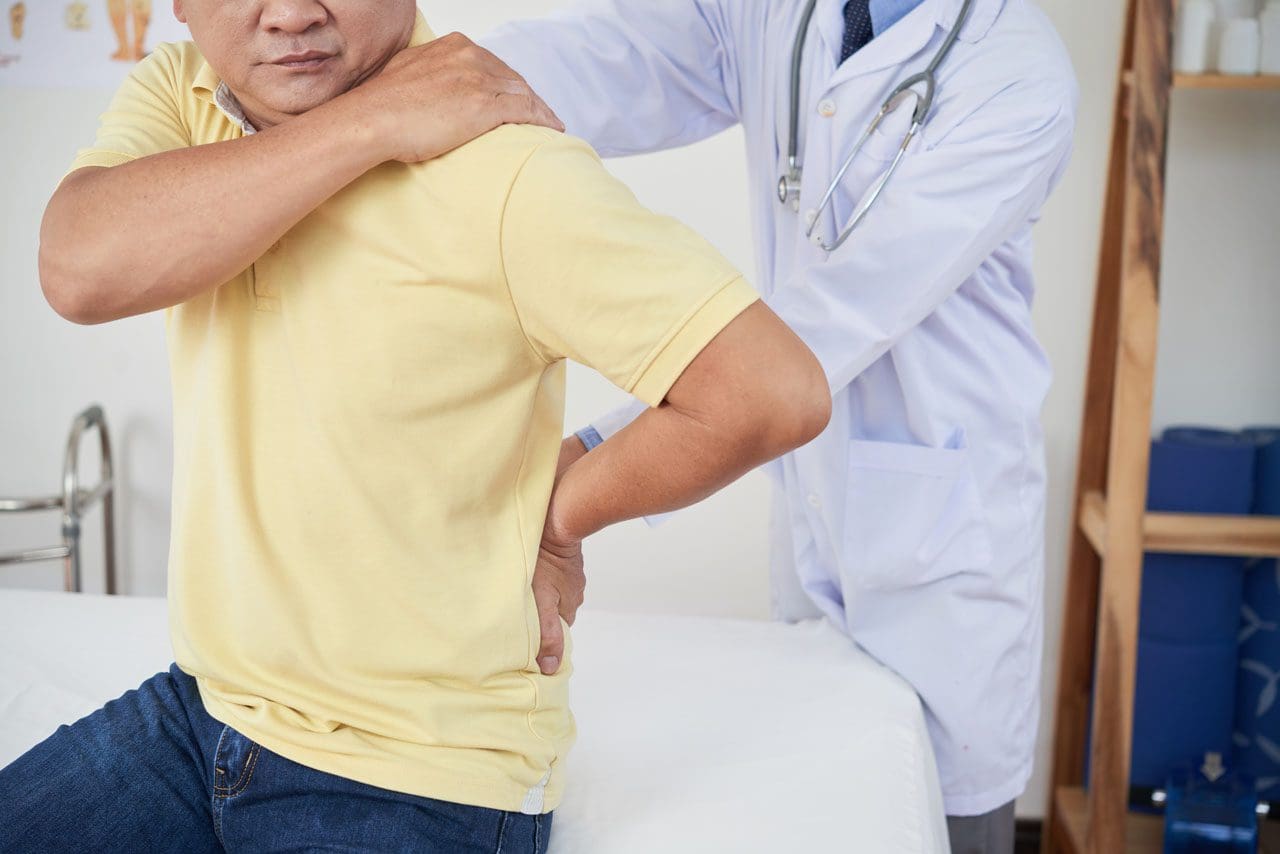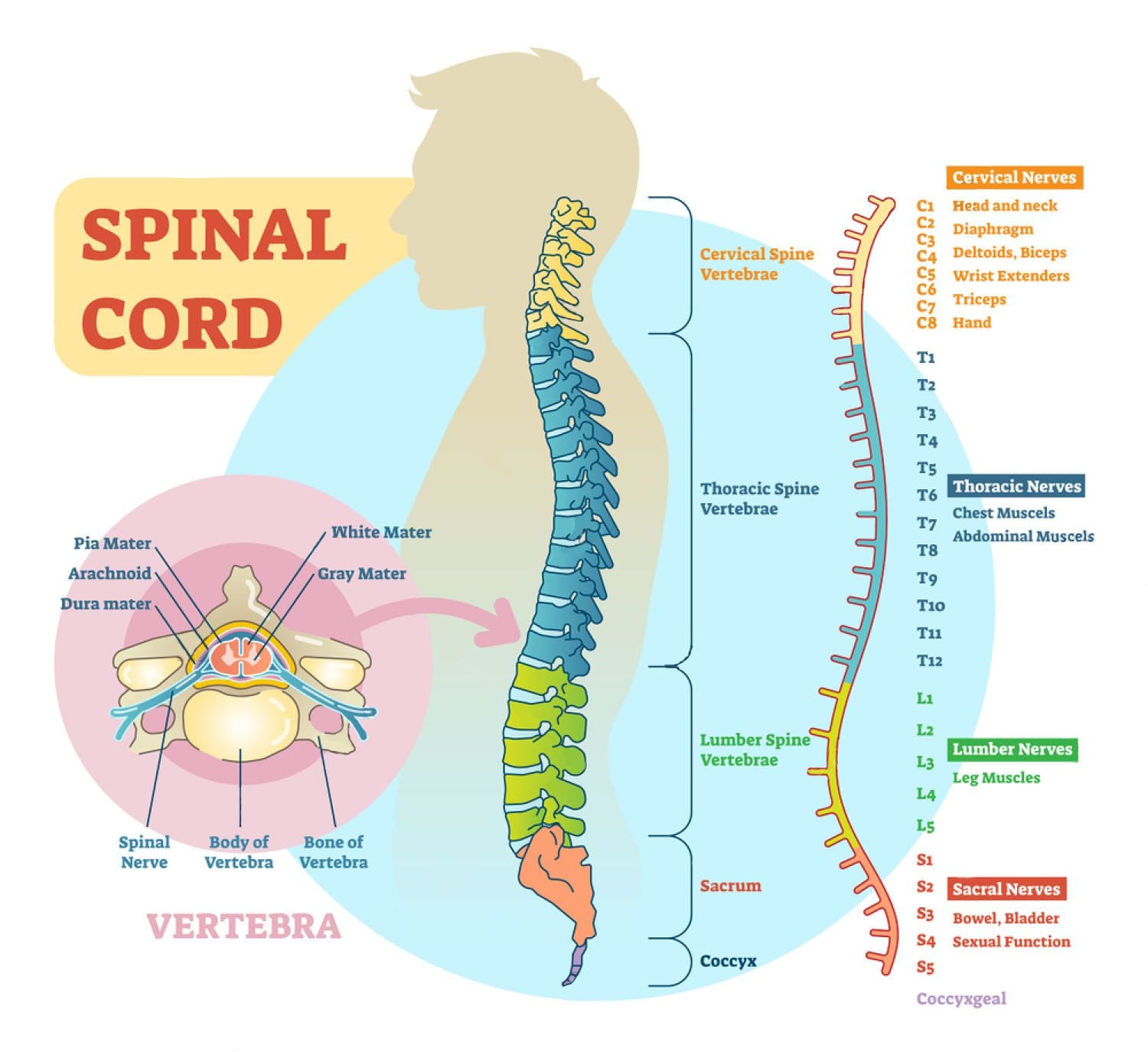Back/spine injuries now rank either second or third overall for workplace injury/s. According to the Bureau of Labor Statistics, over 900,000 cases of back injuries account for 1 in 4 non-fatal job-related injuries that involve workdays missed every year.

Table of Contents
Backcare & Standing Work
Back injuries can be painful, debilitating, and life-changing. 8 out of 10 people will experience a back/spine injury leading to chronic pain and health conditions. We all need to know, especially those who work standing up, firsthand knowledge of how important it is to learn how to improve spine health and take steps to prevent back injury.
To prevent low back disorders, there needs to be an understanding of the spine and knowledge of back injury risk factors.
Back/Spine Basics
The spine is a flexible structure that consists of 24 bones that move, shift, and contort, called vertebrae. There are:
- 7 in the neck
- 12 in the chest
- 5 in the low back

These are connected by ligaments and separated by pads of cartilage, called intervertebral discs. These are the shock absorbers that allow the flexible movement of the spine, specifically at the neck and the low back.
When we stand, the spine naturally curves inwards and outwards. The inward curve is called lordosis and curves towards the front of the body at the lower back and neck area. The outward curve is called kyphosis and curves towards the back of the body around the chest area. When we bend over, the vertebrae of the lower back change position and shift from being in lordosis to kyphosis when completely bent over and then back again when upright. It is easy to see how much we move around, bend, stretch, and reach during a regular day with this information. The lower back gets used the most, which is why low back pain and injury/s and disorders are the most common.

Causes of Low Back/Spine Pain:
- Muscles or ligaments get strained
- Added pressure on the intervertebral discs
- Nerve/s get compressed or entrapped
- Vertebra gets damaged from trauma
The National Institute of Occupational Safety and Health concluded: “muscle strain is the most common type of work or nonwork back pain” (Bernard, 1997). This is good news for chiropractors and ergonomists because we can find ways to reduce/change the way we work and the effort involved to minimize injury risks.

Keeping the intervertebral discs healthy plays an extremely significant role in preventing back/spine injuries. If these discs get damaged and start to degenerate, flexibility begins to fade away, stiffness and soreness sets in, and the ability to absorb the daily pressure/forces that come with standing, moving, and working.
There is not a normal blood supply to the intervertebral discs. Instead, as the discs change shape when we move around, the nutrients they need are absorbed into the discs as the waste products are pumped out. This is why moving the body and staying active is very important. Because as you move, you are literally feeding your spine and expelling the bad stuff. Intermittently changing postures and positions helps change the force and weight on the discs so that not all one area is taking the brunt of the force. Remember to move around and keep your spine as healthy as possible.
Risk factors
Major risk factors for back injuries include:
- Awkward postures
- Bending
- Twisting
- Heavy physical tasks
- Lifting
- Forceful movements
- Whole-body vibration aka W.B.V.
- Static or unmoving work postures
These risks can happen separately or could be a combination of them all, and if these risks are taking place at any one time, the higher probability of an injury/s.
Standing Work
When we stand, the pressure on the lower back discs is relatively low. There is not much pressure, but it is much lower than when seated with an unsupported backrest like bleachers. Standing up uses 20% more energy than sitting does. When we need to bend down to pick up objects or reach overhead objects, there is an increase in the forces and pressure on the lower back, which is when an injury is likely to happen.
Tips to Minimize Injury
Here are some tips to help minimize your risks of back/spine injury when you are doing standing work:
- Moving around is important to keep the spine healthy. Moving will help improve circulation and reduce muscle fatigue.
- Taking consistent short breaks will help reduce fatigue, discomfort and work other muscles.
- Gentle stretching during some of these breaks helps to ease muscle tension and gets circulation pumping.
- Pay attention to your posture and the way you stand as you work.
- Lean on a solid support to help reduce fatigue when you are standing with the support that you can put your back up against, lean against sideways, lean forwards against, and hold on to will increase safety.
- Keep your back strong and try to do exercises that will strengthen the back muscles. Activities like Yoga, Crossfit, HITT, or workouts focused on the spine for flexibility are the way to go.
- Maintain a stable posture with your feet on a firm surface.
- Avoid twisting the lower back around to reach for things.
- Move your feet so that your whole body changes position.
- Minimize bending, but when you have to, bend for objects in front of you and bend at the knees instead of the back. When bending for objects to the side of you, change your stance so you are facing the object, and then bend down at the knees.
- Don’t overreach, but use a step-ladder if you have to reach up to a high area to get something.
- Don’t reach over objects and move the obstruction or change your position before reaching for whatever it is.
Low Back Pain? Get Rid of It With Foot Orthotics
NCBI Resources
The one size fits all method just doesn’t cut it. A more focused approach for every individual leads to better results. Patients find that placing their bodies in certain positions and certain physical activities can:
- Activate
- Aggravate
- Deactivate their back pain.
Patients also find the pain being either better or worse. Understanding why sitting, standing, and walking can change the severity of low back pain can be helpful in diagnosis. These are important cues that help to diagnose and treat low back pain. People sit, stand, and walk all day. This is why so much research has been conducted on how these specific positions and activities contribute to low back pain.
Post Disclaimer
Professional Scope of Practice *
The information on this blog site is not intended to replace a one-on-one relationship with a qualified healthcare professional or licensed physician and is not medical advice. We encourage you to make healthcare decisions based on your research and partnership with a qualified healthcare professional.
Blog Information & Scope Discussions
Welcome to El Paso's Premier Wellness and Injury Care Clinic & Wellness Blog, where Dr. Alex Jimenez, DC, FNP-C, a board-certified Family Practice Nurse Practitioner (FNP-BC) and Chiropractor (DC), presents insights on how our team is dedicated to holistic healing and personalized care. Our practice aligns with evidence-based treatment protocols inspired by integrative medicine principles, similar to those found on this site and our family practice-based chiromed.com site, focusing on restoring health naturally for patients of all ages.
Our areas of chiropractic practice include Wellness & Nutrition, Chronic Pain, Personal Injury, Auto Accident Care, Work Injuries, Back Injury, Low Back Pain, Neck Pain, Migraine Headaches, Sports Injuries, Severe Sciatica, Scoliosis, Complex Herniated Discs, Fibromyalgia, Chronic Pain, Complex Injuries, Stress Management, Functional Medicine Treatments, and in-scope care protocols.
Our information scope is limited to chiropractic, musculoskeletal, physical medicine, wellness, contributing etiological viscerosomatic disturbances within clinical presentations, associated somato-visceral reflex clinical dynamics, subluxation complexes, sensitive health issues, and functional medicine articles, topics, and discussions.
We provide and present clinical collaboration with specialists from various disciplines. Each specialist is governed by their professional scope of practice and their jurisdiction of licensure. We use functional health & wellness protocols to treat and support care for the injuries or disorders of the musculoskeletal system.
Our videos, posts, topics, subjects, and insights cover clinical matters and issues that relate to and directly or indirectly support our clinical scope of practice.*
Our office has made a reasonable effort to provide supportive citations and has identified relevant research studies that support our posts. We provide copies of supporting research studies available to regulatory boards and the public upon request.
We understand that we cover matters that require an additional explanation of how they may assist in a particular care plan or treatment protocol; therefore, to discuss the subject matter above further, please feel free to ask Dr. Alex Jimenez, DC, APRN, FNP-BC, or contact us at 915-850-0900.
We are here to help you and your family.
Blessings
Dr. Alex Jimenez DC, MSACP, APRN, FNP-BC*, CCST, IFMCP, CFMP, ATN
email: coach@elpasofunctionalmedicine.com
Licensed as a Doctor of Chiropractic (DC) in Texas & New Mexico*
Texas DC License # TX5807
New Mexico DC License # NM-DC2182
Licensed as a Registered Nurse (RN*) in Texas & Multistate
Texas RN License # 1191402
ANCC FNP-BC: Board Certified Nurse Practitioner*
Compact Status: Multi-State License: Authorized to Practice in 40 States*
Graduate with Honors: ICHS: MSN-FNP (Family Nurse Practitioner Program)
Degree Granted. Master's in Family Practice MSN Diploma (Cum Laude)
Dr. Alex Jimenez, DC, APRN, FNP-BC*, CFMP, IFMCP, ATN, CCST
My Digital Business Card


